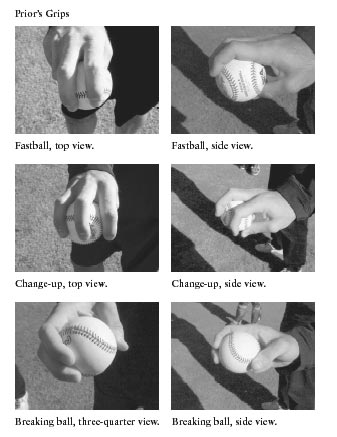 Those who lack pitching velocity want to throw more pitches. The problem is this is a double edged sword. When your pitching velocity is poor, and you want to take the easy way out, you opt for ball movement. This involves trying, or successfully learning, offspeed pitches. Here is a list of these type of pitches.
Those who lack pitching velocity want to throw more pitches. The problem is this is a double edged sword. When your pitching velocity is poor, and you want to take the easy way out, you opt for ball movement. This involves trying, or successfully learning, offspeed pitches. Here is a list of these type of pitches.
Offspeed Pitches:
- Curveball
- Slurveball
- Circle Change
- Forkball
- Knuckleball
- Gyroball
- The "Volken"
I am not saying that these pitches are junk or a waste of time, because many great pitchers have used them. What I am saying is this is always last resort. Especially when you are young. You should expect your pitching velocity to improve all the way into your 20's. If you have plateaued, then you need a pitching velocity enhancement program like the 3X Pitching Velocity Program before you need to learn another pitch. Also learning these offspeed pitches have proven to decrease pitching velocity, because if not thrown correctly, it can add more wear and tear to the arm and it also can change your pitching mechanics. I have seen in my career guys loss a few miles per hour because they fell in love with a Forkball, or a Curveball. I am not saying this is the case for everyone but it is the case for most young pitchers.
The Fastball Philosophy
My philosophy is, you should take a fastball change-up, or fastball cutter or slider combo, as far into your career as you can, before you add a third pitch. Those who have average to below average pitching velocity in your current level, should use the fastball change-up combo. Those of you who have above average pitching velocity at your level of play, should use the fastball cutter or slider combo. This is because when you throw hard, you should stay hard, and when you throw slow, you should change your speeds more often. The reason hard throwers will do better with staying hard, is because a lot of hard throwers make the mistake of going soft when the hitter is still trying to catch up with their pitching velocity. Therefore going soft with a change-up would put the timing of the pitch with the timing of the hitters swing, even if there is a good difference in pitching velocity. This is a very common mistake among young pitchers. I don't know how many times I have seen, with a young pitcher, when he has just thrown two hard fastballs past a hitter and then he comes with a change-up, which is now timed perfectly with the hitters swing. This is why you need a hard cutter, or slider, to finish the hitter off. Stay hard and let it break just a bit, or just stay hard and get it off the plate inside or out.
The other problem with pitchers who opt for ball movement, when their pitching velocity isn't fooling hitters, is those who decide to change arm angles. I would say the same about this approach as the more pitches approach. Use this option late in your career, not early, because if you use it early, it could force you to plateau in your young career.




Hey Brent I just watched Drew's analysis and I wanted to know if I have similar problems, or what are the key differences in us.
You have better mechanics, especially hip to shoulder separation at front foot strike.
Thanks for the comment Brent, I just wanted to say I am committed to your program and I will buy 3x pitching, but I just wanted to know if it covers the lift leg and stride phase clearly because I need practice in that.
Yes, it will give you a lot more information to fully understand the 3X approach to pitching velocity.